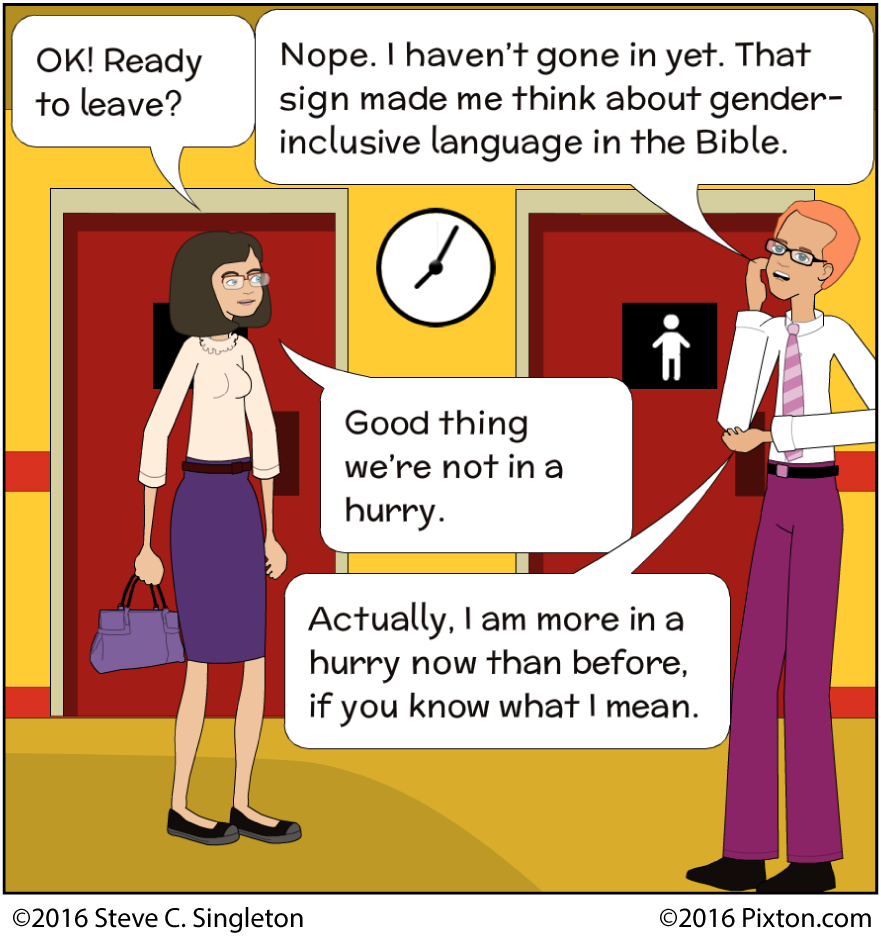Gender-inclusive language in Bible translations
The end of ‘man’ and ‘he’ as generics?
Western culture in the past 40 years has experienced a drastic change in the use of gender inclusive language, moving from amused tolerance in the 1970s to the standard practice of today. ‘Man’ is no longer acceptable as a generic standing for both genders. Neither is the use of masculine singular pronouns, as in the sentence, “If anyone wants to know how to spell a word, he should look it up in a dictionary.”
This change in the English language has affected Christian writers, whose publishers demand a writing style that is gender-neutral as far as possible. When this became standard policy, its application to Bible translations and prayer books was soon to follow. An extreme example is the Inclusive Language Lectionary (ILL) of the National Council of Churches (1983), which consciously avoided calling Jesus Christ God’s ‘Son’ and also replaced third person singular pronouns with reference to either God or Christ. Here is a comparison of the ILL with the RSV (its textual base) in two familiar verses:
John 3:16
RSV: for God so loved the world that he gave his only Son….
ILL: for God so loved the world that God gave God’s only Child….
Philippians 3:20-21
RSV: Jesus Christ, who will change our lowly body to be like his glorious body, by the power which enables him even to subject all things to himself.
ILL: Jesus Christ, who will change our lowly body to be like Christ’s glorious body, by the power which enables Christ even to subject all things to Christ’s self.
Eugene Nida, a prominent linguist of the American Bible Society, made this statement in response to the ILL:
In addition to letting the Scriptures speak for themselves, it is essential to accurately reflect the cultural contexts of biblical times, whether ideological, sociological, or ecological.… The biblical culture was… a male-oriented culture, and to try to rewrite the Scriptures in so-called “inclusive language” introduces cultural anachronisms and serious contextual distortions.
Most modern translations have attempted, to a greater or lesser degree, to accommodate the demands for gender-neutral language. Most of them have been more conservative in their approach and the ILL. The 2011 revision of the NIV, for example, features a number of changes that remove generic masculine nouns and pronouns.
The literal ‘sons of Israel’ often appears as ‘Israelites’ (e.g., Ex. 10:23; Ex. 16:6). Genesis 9:6, which in the more literal ESV stands as, “Whoever sheds the blood of man, by man shall his blood be shed, for God made man in his own image” becomes “Whoever sheds human blood, by humans shall their blood be shed; for in the image of God has God made mankind.”
Although you may assume that the use of gender-neutral language is a recent phenomenon, you might be surprised to learn that the time-honored King James Version (also called the Authorized Version) sometimes uses gender-neutral terms, such as regularly replacing ‘sons of Israel’ with ‘children of Israel’ and using ‘children’ instead of ‘sons’ in passages like Gal. 3:26.
Passages to check with your favorite translation
You can check your own translation if you use it to look up the following passages for each of these terms that are used as generics in Scripture:
- MAN (rendered ‘one,’ ‘person,’ etc.) – Gen. 3:22; Gen. 6:3; Gen. 6:6; Gen. 9:6; Deut. 8:3; 1 Sam. 13:14; 1 Sam. 15:29; 1 Sam. 16:7; Job 14:1; Job 14:14; Ps. 1:1; Ps. 8:4; Ps. 32:2; Ps. 40:4 etc.; Mark 8:36; Luke 4:4; Rom. 5:12; 1 Cor. 2:15; 1 Cor. 3:12; 1 Cor. 13:11; 1 Cor. 15:21; 2 Cor. 12:2; Eph. 2:15; Philippians 2:8; 1 Tim. 2:5; 1 Tim. 2:11; 2 Tim. 3:17; Heb. 2:6; Heb. 9:27.
- MEN (rendered ‘people,’ ‘men and women,’ etc.) – Ps. 9:20; Ps. 11:4; Matt. 4:19; Matt. 5:16; Matt. 6:14; Matt. 10:32; Matt. 12:31; Matt. 12:36; Matt. 23:5; Mark 7:7; Luke 6:22; Luke 6:26; John 1:4; John 2:24; John 3:19; John 12:32; John 13:35; Acts 5:29; Rom. 1:18; Rom. 5:12; 1 Cor. 2:11; 1 Cor. 3:3; 1 Cor. 3:21; 1 Cor. 9:22; 1 Cor. 13:1; 1 Cor. 16:13; 2 Cor. 5:11; 2 Cor. 8:21; Gal. 1:1; Gal. 1:10; Eph. 4:8; 1 Thess. 2:4; 1 Thess. 2:13; 1 Tim. 2:4; 1 Tim. 2:6; 1 Tim. 4:10; 1 Tim. 5:2; 2 Tim. 2:12; Titus 2:11; Heb. 5:1; Heb. 7:28; 1 Peter 1:21; Rev. 21:3.
- SON (rendered ‘child,’ etc.) – Gen. 3:16; Gen. 21:7; Ex. 21:5; Ex. 22:24; Deut. 6:20; Deut. 8:5; Deut. 11:31; Deut. 21:18; Judges 20:15; Prov. 3:12; Prov. 13:24; Prov. 29:17; Ezekiel 18:20; Matt. 7:9 par. Luke 11:11; Luke 14:5; Heb. 12:6
- SONS (rendered ‘children,’ etc.) – Ps. 127:3; Ps. 132:12; Hosea 1:10; Matt. 5:9; Luke 6:35; John 12:36; Rom. 8:14; Rom. 9:26; Gal. 3:26; Gal. 4:5-6; Heb. 12:7
- BROTHER (rendered ‘brother or sister,’ ‘relative,’ etc.) – Prov. 19:7; Prov. 27:10; Matt. 7:5; Matt. 18:15; Mark 3:35; Luke 17:3; Rom. 14:13; Rom. 14:15; 1 Cor. 8:13; 2 Thess. 3:6; 2 Thess. 3:15; Philemon 16; James 2:15; James 4:11; 1 John 2:9-11; 1 John 3:10; 1 John 3:15; 1 John 3:17; 1 John 4:20; 1 John 4:21; 1 John 5:16.
- BROTHERS (rendered ‘relatives,’ ‘brothers and sisters,’ etc.) – Josh. 2:13; Josh. 6:23; Ps. 22:22; Ps. 69:8; Ps. 122:8; Ps. 133:1; Prov. 6:19; Prov. 17:2; Prov. 19:7; Isa. 66:5; Isa. 66:20; Jer. 7:15; Jer. 12:6; Jer. 29:16; Jer. 49:10; Ezekiel 11:15; Matt. 5:47; Matt. 25:40; Luke 14:12; Luke 18:29; Luke 21:16; Acts 1:16; Acts 6:3; Acts 11:29; Acts 12:!7; Acts 16:40; Acts 18:27; Acts 21:7; Acts 28:14-15; Rom. 1:13; Rom. 7:1; Rom. 7:4; Rom. 8:29; Rom. 10:1; Rom. 12:1; Rom. 15:14; Rom. 15:30; Rom. 16:17; 1 Cor. 1:10-11; 1 Cor. 1:26; 1 Cor. 2:1; 1 Cor. 3:1; 1 Cor. 4:6; 1 Cor. 6:8; 1 Cor. 7:24; 1 Cor. 10:1; 1 Cor. 11:33; 1 Cor. 12:1; 1 Cor. 14:6; 1 Cor. 14:20; 1 Cor. 14:39; 1 Cor. 15:1; 1 Cor. 15:6; 1 Cor. 15:50; 1 Cor. 15:58; 1 Cor. 16:15; 1 Cor. 16:20; 2 Cor. 8:1; 2 Cor. 8:23; 2 Cor. 13:11; Gal. 1:2; Gal. 1:11; Gal. 3:15; Gal. 4:12; Gal. 4:28; Gal. 4:31; Gal. 5:11; Gal. 5:13; Gal. 6:1; Gal. 6:18; Eph. 6:23; Philippians 1:12; Philippians 1:14; Philippians 3:1; Philippians 3:13; Philippians 3:17; Philippians 4:1; Philippians 4:8; Philippians 4:21; Col. 1:2; Col. 4:15; 1 Thess. 1:4; 1 Thess. 2:1; 1 Thess. 2:9; 1 Thess. 2:14; 1 Thess. 2:17; 1 Thess. 3:7; 1 Thess. 4:1; 1 Thess. 4:10; 1 Thess. 4:13; 1 Thess. 5:1; 1 Thess. 5:12; 1 Thess. 5:14; 1 Thess. 5:25; 1 Thess. 5:27; 2 Thess. 1:3; 2 Thess. 2:1; 2 Thess. 2:13; 2 Thess. 2:15; 2 Thess. 3:1; 2 Thess. 3:6; 2 Thess. 3:13; 1 Tim. 4:6; 2 Tim. 4:21; Heb. 2:12; Heb. 3:1; Heb. 3:12; Heb. 10:19; Heb. 13:1; Heb. 13:22; James 1:2; James 1:16; James 1:19; James 2:1; James 2:5; James 2:14; James 3:10; James 3:12; James 4:11 (twice); James 5:7; James 5:9-10; James 5:12; James 5:19; 2 Peter 1:10; 1 John 3:13; 1 John 3:16; 3 John 5; Rev. 6:11; Rev. 19:10.
Want to go deeper?
Here are some resources on this issue that will help you hear both sides of the ongoing debate:
Discusses this history of the Inclusive Language Lectionary and gives sample readings, including readings that attempt to remove all gender with reference to both God and Christ.
-
- “Gender neutrality in English” (Wikipedia)
Discussion of the movement seeking to remove male-generics in English generally.
-
- John Gastil – “Generic Pronouns and Sexist Language: The Oxymoronic Character Of Masculine Generics” (1990)
Making a proactive defense of these changes and explaining why male generics are being rejected by those in authority in printing and publishing, and therefore among writers.
-
- Nancy Hardesty – Inclusive Language in the Church (1987)
A relatively early argument in favor of dispensing with male generics in all Christian communicaitons.
-
- Steve C. Singleton – “Is God Female?” (first published, 1978)
Explains why this should not be applied to God, despite feminine similes and metaphors for God throughout Scripture, in addition to the overwhelming number of male similes and metaphors.




